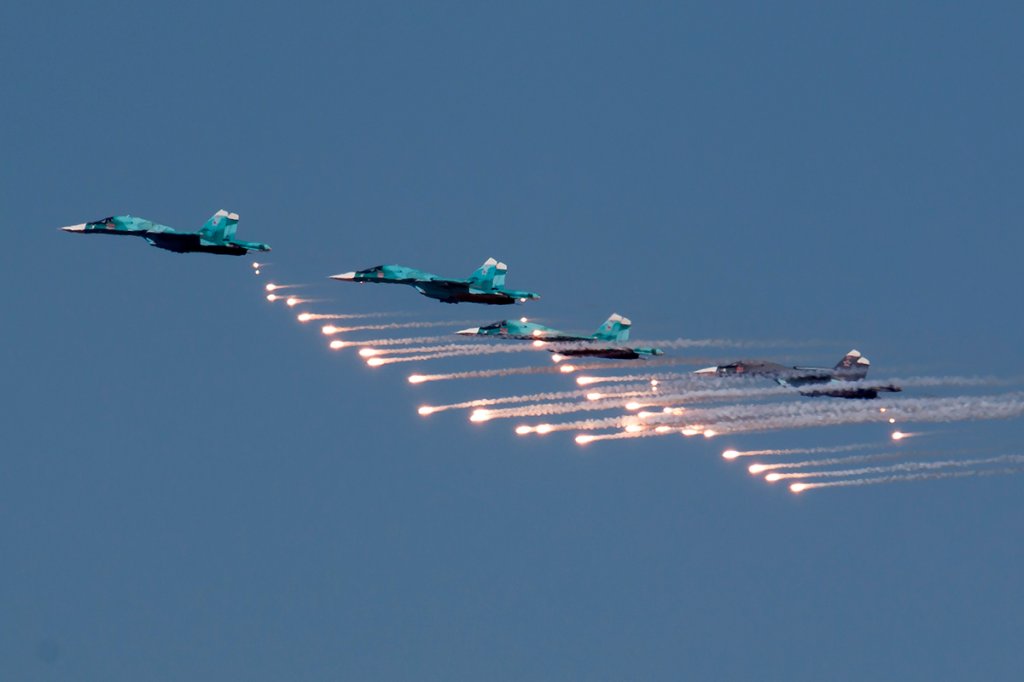The Ukrainian air force claims three kills of Russian Su-34 medium bombers over the frontlines in southern Ukraine on December 22. If true, the Russians likely got too cocky or too desperate and sent the coveted assets into dangerous airspace. Russia holds its air force assets close, rarely risking them, and so will feel the loss of three bombers quite keenly.
Since the Su-34 fires many of the gliding bombs that devastate Ukrainian cities, taking out three likely saves hundreds of lives. And it might force Russia to be more careful with its remaining jets.
Russia uses jets to conserve helicopters
The Russian air force protected its assets for most of 2022-2023. Its jets featured heavily in the initial invasion (without taking out Ukrainian air defenses, we might point out), but largely disappeared after some heavy losses. The losses, while painful, didn’t nearly account for how much jet sorties fell off.
Instead, Russia pivoted to using its helicopters, which could more easily hide below evolving Ukrainian air defenses. The helicopters inflicted heavy damage on Ukrainian forces, especially with long-range, inaccurate rocket strikes. The videos of Russian and Ukrainian helicopters conducting the strikes went viral. They are, admittedly, pretty fun (for everyone except the groundpounders receiving them).
But, of course, Ukraine got better at downing the helicopters, as well. And then Ukraine got a few Army Tactical Missile Systems. The missiles fire from HIMARS launchers but have much higher max range than regular HIMARS. America transferred the missiles in secret, and Ukraine debuted them in stunning fashion.
In its first ATACMS strike, Ukraine destroyed air defenses and helicopters at Berdyansk and Luhansk. That forced Russia to pull many helicopters back further from the front. And with Ukraine getting better at hitting the helicopters on the ground and in the air, Russia turned back to jets.
The jets typically stay far back from Ukrainian air defenses, lobbing glide bombs and other long-range munitions. With the long range of Russia’s glide bombs, missiles, and “hypersonic” missiles (which aren’t really hypersonic), the jets rarely have to broach Ukraine’s air defenses.
Ukraine kills three Su-34s
But then this morning happened.
The Russians rely on Su-34s and Su-35s for many of their strikes. They’re both multi-role jets, with the Su-35 a little more focused on air-to-air and the Su-34 better for air-to-ground.
And Ukraine’s air force claimed in a very short, celebratory tweet on Friday morning that they’d downed three of the Su-34s in the south, with no other details. Ukraine killing three Su-34s means a loss of over $100 million in hardware, potential loss of air crews, and a huge hit to the morale of pilots lobbing glide bombs.
Speculation, of course, went wild.
Speculation
First, some claimed that Patriot missile launchers killed the jets. That’s definitely possible, but it would indicate a large, calculated risk on Ukraine’s part.
The glide bombs are a new technology, but the smaller, more common ones appear to have a range of about 43 miles. And Russia showed off a larger version that tops out at around 25 miles. Since Patriots can fire 62 miles and see out 93 miles, a Patriot positioned fairly close to the frontlines could spot a Russian flight and hit them.
But that would put the Patriot launchers and radar in risky territory. Since Ukraine has only a few batteries, cannot replace them, and needs them to protect cities, it would be surprising for them to be risked in that way. If the jets were downed by Patriots, though, it would mean that Ukraine took a big gamble and it paid off huge.
Some other speculation was that Russia must’ve lost six pilots as well. That is even less sure. Patriot missiles in service are mostly PAC-2 or PAC-3 missiles. The 2s get close to a target and then detonate, creating a large cloud of shrapnel. The 3s get “body-to-body” contact and detonate a much smaller warhead.
Either way, it doesn’t take too much luck for a pilot to see the threat and either punch out before the missile detonates or survive the initial hit and bailout. It would be surprising if all six died or if all six survived. And since the jets almost certainly didn’t cross the frontlines, any survivors would land in friendly territory.
Regardless, it’s a great day for Ukraine and democracy. Here’s hoping for three more by Christmas.
Logan was an Army journalist and paratrooper in the 82nd Airborne Division. Now, he’s a freelance writer and live-streamer. In addition to covering military and conflict news at WeAreTheMighty, he has an upcoming military literacy stream on Saturdays in 2024 on Twitch.tv/logannyewrites.
Read more on WATM:
Why Ukraine’s new mine hunters might not join war


